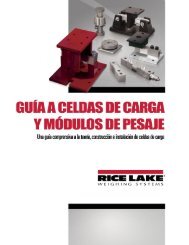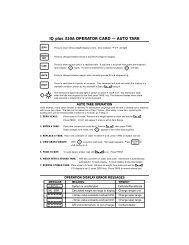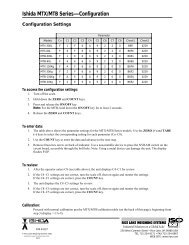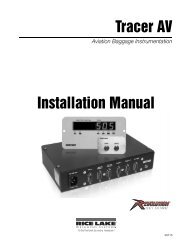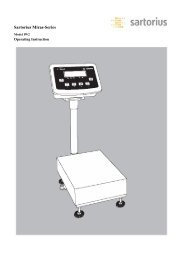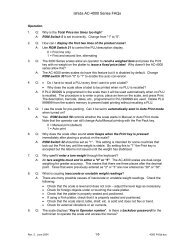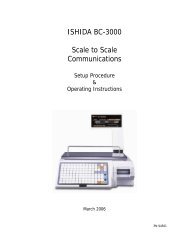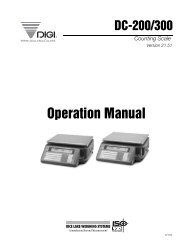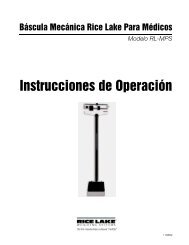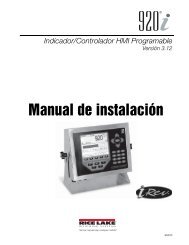IQ plus 810 - Rice Lake Weighing Systems
IQ plus 810 - Rice Lake Weighing Systems
IQ plus 810 - Rice Lake Weighing Systems
- No tags were found...
You also want an ePaper? Increase the reach of your titles
YUMPU automatically turns print PDFs into web optimized ePapers that Google loves.
DISPTAREIn the normal weighing mode, the DISPLAY TARE key is used to display the current tare weightin the tare weight register. When the DISPLAY TARE key is pressed, the T annunciator will lightand the current tare weight will be displayed. The displayed tare weight will remain on the displayuntil time-out occurs or another function key is pressed.In the Truck In/Out Mode, if any number is keyed in followed by the DISPLAY TARE key, thenumber will be displayed if it is in the system as a truck ID. If the keyed number isn't in memory,it will not remain on display. With a valid stored ID displayed, pressing the CLEAR key promptsthe operator, “CLR ID?”. Pressing the CLEAR key again, clears the stored ID from the system.In the Truck In/Out Mode, DISPLAY TARE is also used to place the indicator in a "memoryaccess" mode where all stored ID numbers in the system's memory can be viewed, or all truckID numbers and associated tares can be printed. See Section 3.4 for more information.TIME/DATEThe TIME/DATE key is used to display time and date information. When the TIME/DATE key ispressed, the display shows time information in the form HH.MM or MM.HH. If the TIME/DATEkey is pressed again, date information is displayed in the form MM.DD.YY or DD.MM.YY. Toupdate either the time or the date, the operator can enter numeric information while the time ordate is displayed (before time-out) and then press the ENTER key. The entered data will becomethe current time/date. All time values entered should be in 24-hour, military format. The indicatorwill automatically assign "AM" or "PM" if 12-hour formatting has been selected.DISPACCUMThe DISPLAY ACCUMULATE key is used to display the weight which is in the accumulateregister. When the operator presses the DISPLAY ACCUM key, the accumulate annunciator isactivated and the current accumulated weight is displayed. If the CLEAR key is pressed, theoperator is prompted “CLR AC?”. If the CLEAR key is then pressed, the accumulation is clearedfrom the system. If the optional Accumulate feature is not installed, this key is non-functional.DISPROCThe DISPLAY RATE OF CHANGE key is used to display the rate of change of the weight dataon the current analog input. The rate of change is expressed as change in weight over a presetperiod of time (lbs/min, gals/hour, etc.).Pressing the DISPLAY RATE OF CHANGE key will immediately switch the display to the Rateof Change Mode if any other mode is currently displayed. The ROC annunciator will also lightin this mode. If the optional Rate of Change feature is not installed, this key is non-functional.NEWI.D.The NEW IDENTIFICATION NUMBER key is used in the Truck In/Out program to enter a truck'sID number which has been keyed into the system with the numerical keyboard. When a truck isbeing weighed on the scale, entering the truck's ID number then pressing NEW ID will both enterthe number and associated tare, and send a command to print out a weigh-in ticket.SCALE#The BASE # (Survivor ® Model) or SCALE # (Desktop and Stainless Steel Models) key is usedto select the desired analog input source channel that is displayed, or a total of selectedcombinations of source channels. The combinations available for totalling are selectable in thesetup menu.Pressing this key displays the next available source channel (scale #) and lights the annunciatorlight for that scale #. Successive presses of the key scrolls the source input options available andlights the appropriate scale # annunciator. More than one scale # annunciator will light to indicatesources which are totalled. If the indicator has only the standard single-channel A/D input module,this key is non-functional.2 - 3



